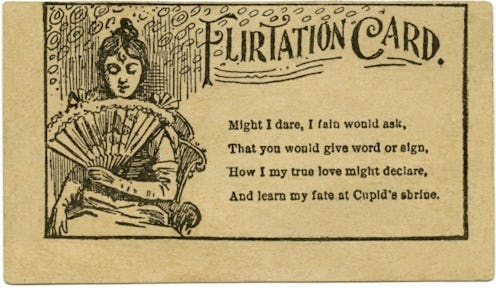
Striking out on Tinder? Listen up, ladies and gents — if you're looking to catch a special someone's attention, perhaps you should make like it's the Gilded Age and pass the object of your affection a Victorian "flirtation card." Not only would you inevitably score some points for originality, but these cheeky little suckers are (if nothing else) good for a laugh. And, hey, that's gotta count for something; after all, humor is one of the most desired traits in a potential partner.
According to National Geographic, men and women in the ultra-proper Victorian era had little choice but to rely on these cards to score a date. In the absence of online matchmaking sites or modern bars, they were relegated to delivering their pick-up lines more discreetly. Here's the gist: In the 19th century when a man and a woman passed each other on the street, the man would first make eye contact with a woman to express interest. If the woman wanted to follow up on said interest, she would dangle her handkerchief in his direction. Amazingly, that is not a euphemism for anything naughty. At that point, one of the two — typically the man, but not always — would hand the other a personal calling card, or invitation card.
Alan Mays, who has amassed a glorious collection of these quirky cards, asserts they were all in good fun and never taken too seriously. "Acquaintance cards contained a gentle humor that was intended to break the ice and subvert the conventions of the more formal rule-bound visiting cards," he said recently to NPR. Adding to their light-hearted subversiveness was the fact these saucy invitations were modeled after the Victorian calling cards members of high society at the time left at each other's houses to introduce themselves or express routine sentiments such as condolences.
According to the local Union dated Dec. 18, 1878, invitation cards were sold for less than a penny a piece and proved quite the hot commodity. All over the country, 19th century shopkeepers kept them stocked, and many businesses handed them out to customers as a novel marketing tactic. In 1879, an invitation card was even called into testimony at the murder trial of a man accused of killing his wife — supposedly as evidence the accused had dalliances with women who weren't his wife.
Some of these flirtatious calling cards were cutesy, using flowery language and pastoral imagery.
Some were deliberately funny.
There were those that were comically naughty, too.
Some played on existing tropes of masculinity and spinsterhood.
There were a few that seem to have come from predecessors of the #Ocadoandchill guy.
And, well, there were a few that gave a distinct creeper vibe.
Personally, I'm drawn to this bold and a bit smart-assy version.
So there you have it. Should you feel inclined, break out one of these Victorian flirtation cards the next time you're cruising for potential dates at the local bar. Just remember, they could be used against you in a court of law. Or, you know, the court of public opinion. Don't say I didn't warn you.